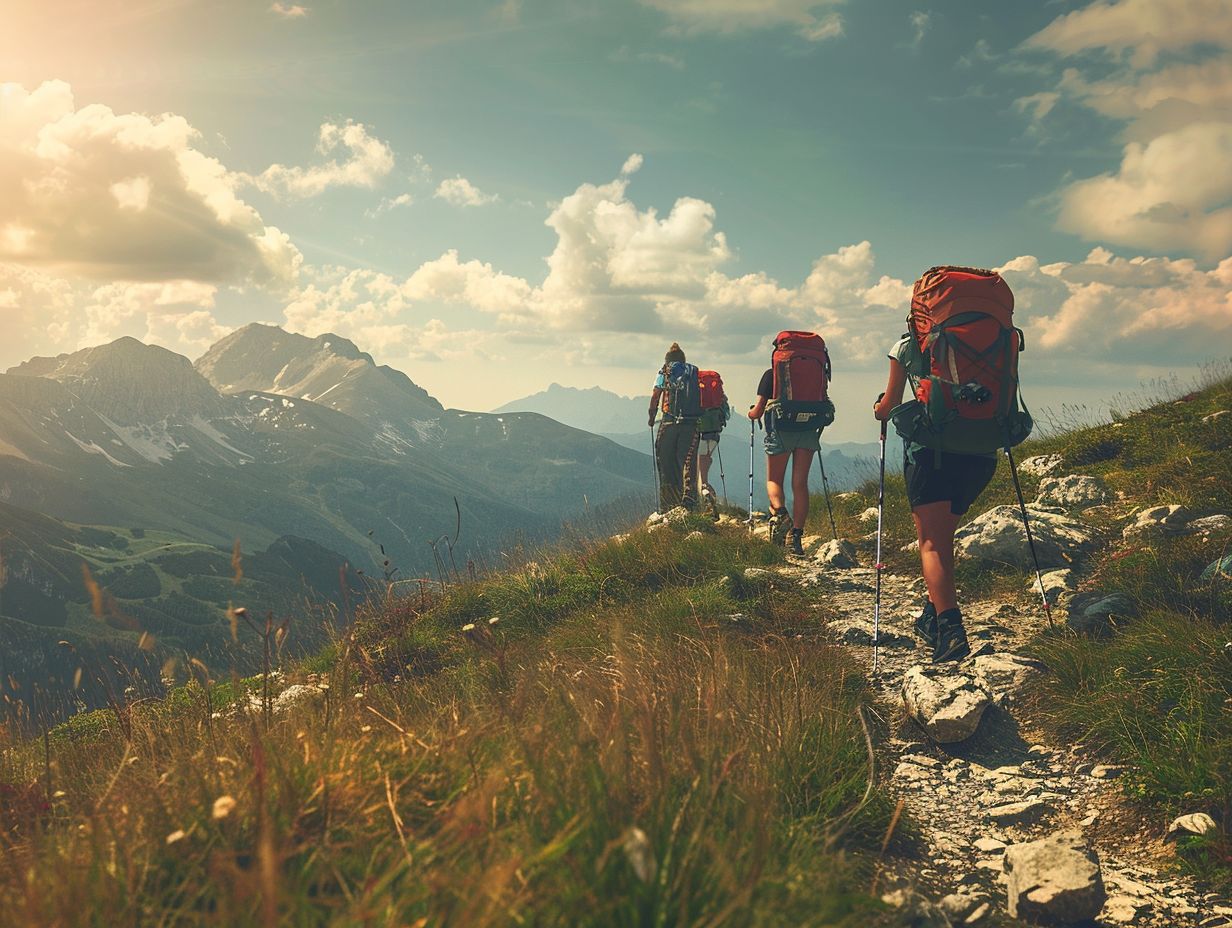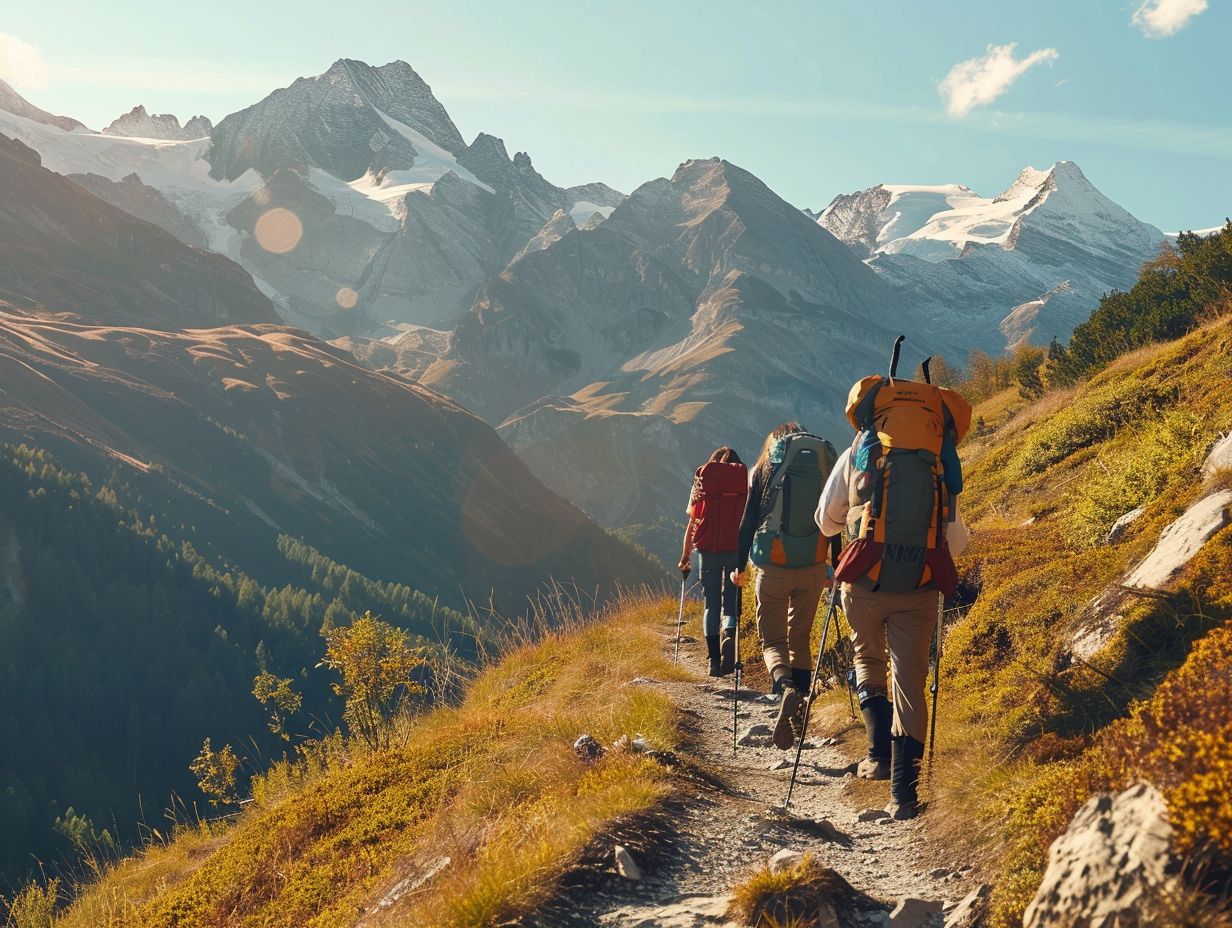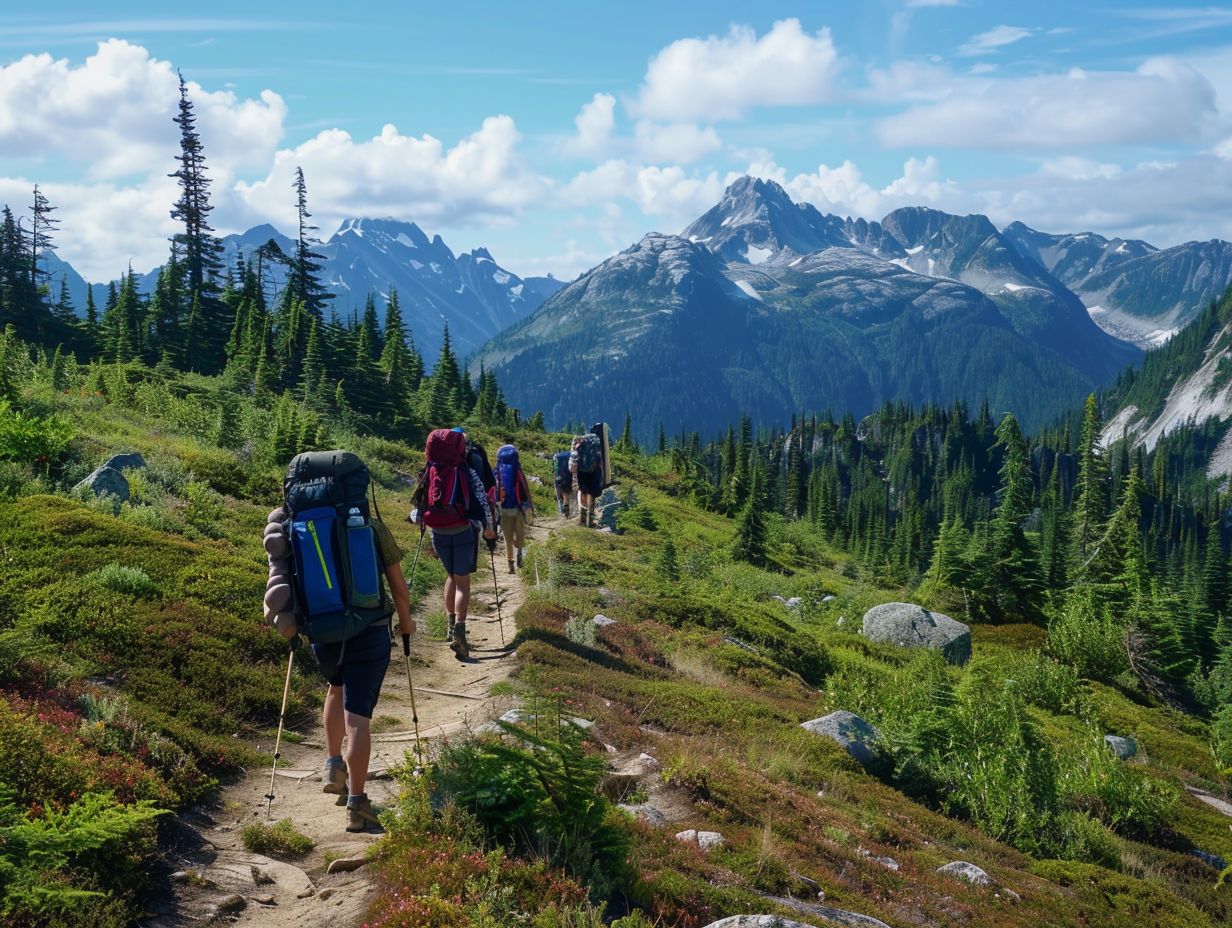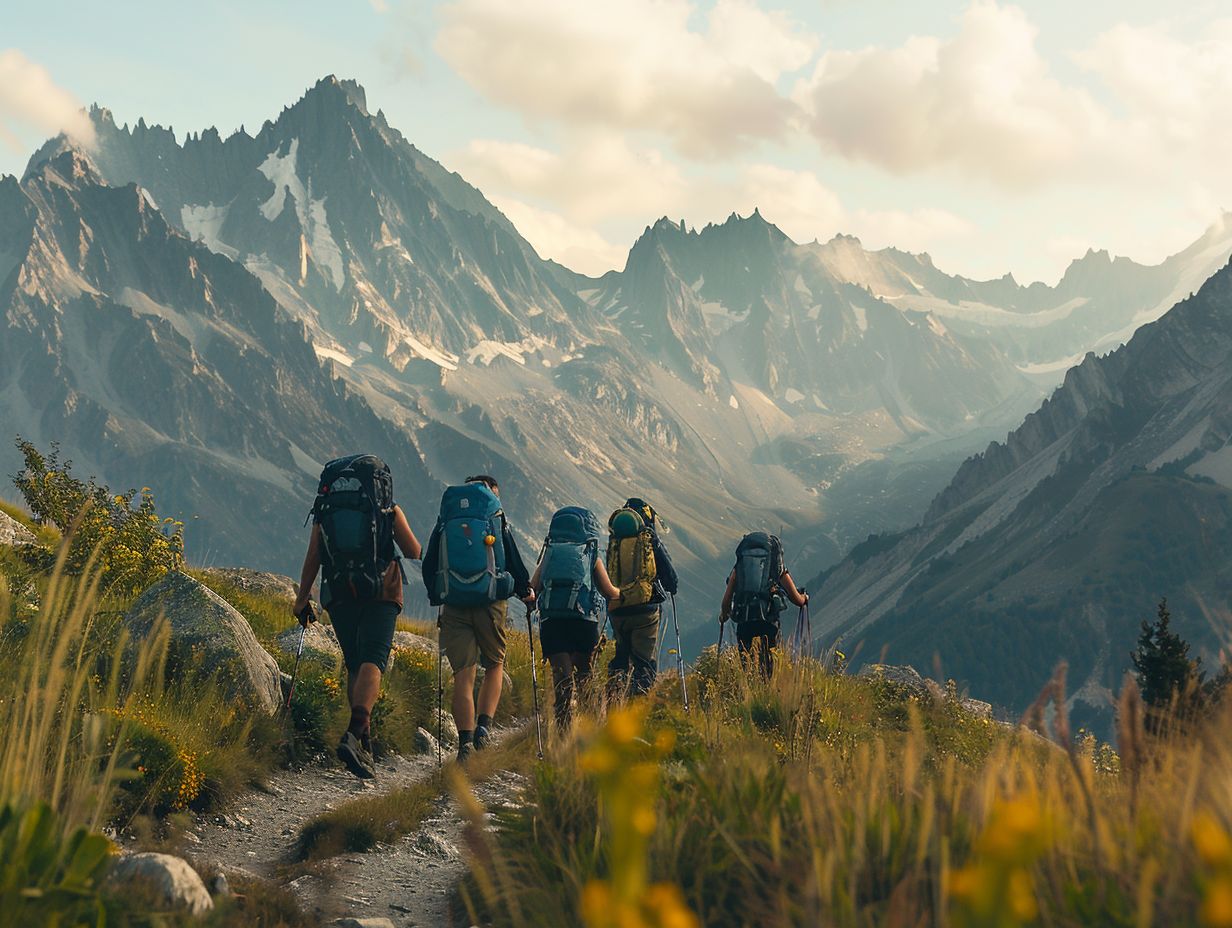Are you ready to start an exciting multi-day hiking adventure but finding the planning process overwhelming? Don’t worry! This detailed guide offers all the essential information, from choosing the perfect hiking destination to preparing yourself physically and mentally for the upcoming journey.
Discover important gear, route planning tips, nutrition advice, camping essentials, and safety precautions to ensure a successful and enjoyable trek.
Get ready to hit the trails and make unforgettable memories in the great outdoors!
Key Takeaways:

- Proper preparation is essential for a successful multi-day hiking trip. This includes physical and mental training, choosing the right gear, and planning your route and itinerary.
- When choosing a hiking destination, consider factors such as terrain, weather, and difficulty level. Researching and mapping out your route can help ensure a safe and enjoyable experience.
- Proper nutrition and hydration are crucial for sustained energy and endurance on a multi-day hike. In addition, knowing how to choose a safe and suitable campsite and staying aware of potential hazards on the trail is key to staying safe while hiking.
Preparing for a Multi-Day Hiking Trip
When gearing up for a multi-day hiking expedition, preparation is crucial for ensuring a safe and successful journey.
To start, equip yourself with essential backcountry gear and emphasise safety protocols. Building endurance is essential to mitigate potential injuries, and fostering mental resilience will help you overcome challenges during the trek.
Before embarking on a multi-day hiking trip, pay close attention to your gear selection. Choose lightweight, moisture-wicking clothing, sturdy hiking boots, a well-fitted rucksack, ample water supply, and a reliable first aid kit. Implement safety practices like informing others of your itinerary, checking weather forecasts, and carrying a map and compass.
Incorporating strength and endurance training into your fitness routine will enhance your physical preparedness for trekking through various terrains for long hours.
Physical and Mental Preparation

To achieve the ideal physical and mental state for a multi-day hiking excursion, you must take a comprehensive and holistic approach. This involves implementing thorough training routines that focus on achieving balance, flexibility, and strength, while also adhering to core principles of endurance and resilience.
Preparing for a challenging hike requires engaging in specific training exercises that target cardiovascular endurance and muscular strength. Incorporating cardio workouts such as hiking, running, or cycling can boost stamina, while integrating strength training through activities like weightlifting or body-weight exercises helps build the necessary muscle power.
It is crucial to include balancing exercises such as yoga or stability drills to enhance core stability and reduce the risk of injuries on rugged terrains.
Moreover, mental fortitude plays an equally vital role. Utilising visualization techniques and mindfulness practices can assist hikers in maintaining focus and resilience when facing physical challenges.
Essential Gear for Multi-Day Hiking
When preparing for a multi-day hiking trip, it is essential to choose the appropriate gear to ensure a safe and enjoyable experience. Key items to include are reliable backpacking gear, sturdy footwear suitable for the terrain, and emergency supplies in case evacuation becomes necessary.
A high-quality backpacking rucksack is vital for comfortably carrying all necessary items, featuring adjustable straps and multiple compartments for efficient organisation. Select durable hiking boots or shoes with reliable grip to navigate diverse terrains effectively.
In terms of emergency readiness, pack essential items such as a first aid kit, a survival foil blanket, a whistle, and extra food and water. Ahead of beginning your hiking adventure, familiarise yourself with potential evacuation routes and emergency contact information to be fully prepared for any unexpected situations.
Must-Have Items and Tips for Packing
In preparing for a multi-day hiking trip, creating a meticulous gear list and packing efficiently are critical steps. Ensuring you have an adequate food supply and maintain nutritional balance, checking weather forecasts, and obtaining necessary permits are essential for a smooth and safe adventure.
When planning for long hikes, it is crucial to consider the nutritional requirements. It is advisable to pack lightweight, high-energy foods like nuts, dried fruits, energy bars, and dehydrated meals to sustain your energy levels. Meal planning should include a balance of carbohydrates, proteins, and fats to adequately fuel your body.
Regarding weather forecasts, it is important to pack layers for potential changes in weather conditions, including waterproof gear for rain or unexpected shifts in the weather. Obtaining permits for backcountry access is vital for complying with regulations and ensuring safety by monitoring hikers in remote areas.
Planning Your Route and Itinerary
When preparing for a multi-day hiking expedition, ensuring you have a well-thought-out route and itinerary is crucial for a successful journey.
This includes identifying important waypoints and landmarks, as well as creating a comprehensive itinerary that takes into consideration the different terrains and daily mileage objectives.
By meticulously planning your route beforehand, you can anticipate potential obstacles, allocate adequate time for rest breaks, and ensure you stay on course towards your final destination. Having a structured itinerary also allows for contingency planning in case of unexpected events like severe weather or changes in trail conditions.
Selecting the appropriate waypoints along the trail not only helps with navigation but also enriches the overall hiking experience by providing opportunities to explore scenic viewpoints and significant natural features.
Additionally, identifying landmarks adds depth to your adventure, offering historical context and memorable sights throughout your journey.
Mapping Out Your Hiking Route
When navigating the wilderness, meticulous route planning is essential for a successful journey. You must consider various factors, such as altitude variations, fitness requirements, potential wildlife encounters, and obtaining necessary permits for specific regions.
In mapping a hiking route, it is crucial to carefully evaluate the altitude changes along the path to ensure a safe and manageable ascent. It is important to take into consideration the fitness levels of all individuals in the group, as well as the challenges presented by steep inclines or rough terrain.
Awareness of potential wildlife encounters is vital for both safety and conservation efforts. Additionally, obtaining permits for specific areas is not only a legal obligation but also aids in regulating visitor numbers and preserving the natural environment.
Food and Water Planning

Proper planning for food and water is crucial for the success of your multi-day hiking expedition. Ensuring you have enough meals, staying adequately hydrated, maintaining nutritional balance, and preparing for unexpected situations are key factors in sustaining your endurance and well-being throughout your journey.
As you set out on your multi-day hike, it is important to carry lightweight, high-energy snacks such as nuts, dried fruits, and energy bars to keep your energy levels up while on the trail. Including dehydrated meals and instant soups in your packing list can offer hot, satisfying meals without the extra weight of fresh produce.
Your hydration plan should involve a mix of water, electrolyte drinks, and water purification methods to guarantee safe drinking water during the entire journey. Planning your nutrition requirements in advance of the trip can help you meet your energy needs and maintain your stamina during long days of hiking.
Nutrition and Hydration Tips for Multi-Day Hiking
Proper nutrition and hydration play a pivotal role in sustaining you during extended camping trips. Adhering to safety guidelines, adapting to varying weather conditions, and ensuring adequate travel provisions enhance endurance and optimise your hiking experience.
To combat fatigue and maintain energy levels while trekking through rugged terrain, it’s essential for you to consume a balanced diet rich in carbohydrates, proteins, and healthy fats. Portable high-energy snacks like nuts, dried fruits, and energy bars can provide quick bursts of fuel on the go.
Staying hydrated is equally crucial, especially in hot climates where water loss through sweating is rapid. Packing a reliable water filtration system or purification tablets ensures a safe drinking source along your journey.
Adjusting your meal plans to include lightweight, nutrient-dense foods can lighten your rucksack load without compromising on nutrition.
Camping and Safety Considerations
When embarking on multi-day treks, it is crucial for hikers to select a secure campsite and prioritize safety measures. By being prepared for wildlife encounters, establishing a functional camp setup, and understanding emergency protocols, you can ensure a safe and memorable outdoor adventure.
To anticipate potential wildlife encounters and react appropriately, take the time to research the specific area’s wildlife and their behaviors. Properly storing food, maintaining a clean campsite, and responsibly disposing of waste not only protect wildlife but also minimise the risk of unwanted visitors during the night.
Along with wildlife considerations, it is essential to carry a well-equipped first aid kit, have a reliable communication device, and inform others about your planned itinerary for emergency readiness.
Implementing safety protocols such as knowing the nearest exit routes and establishing a designated meeting point in case of separation can further enhance the overall safety of your hiking expedition.
Choosing a Campsite and Staying Safe on the Trail
When embarking on a multi-day hiking journey, you must carefully select an optimal campsite location and adhere to safety precautions while on the trail.
Various factors, including transportation logistics, permit requirements, physical fitness, and adherence to basic safety principles, all contribute to ensuring a well-rounded backcountry experience.
When choosing a campsite for multi-day hiking adventures, it is imperative to take into account considerations such as proximity to water sources, protection from wind, and level ground for setting up tents. It is essential to ensure that your camp is situated at a safe distance from potential dangers like cliffs or flash flood zones to ensure a restful night’s sleep.
Regarding trail safety, hikers should always carry essential items such as a map, compass, and first aid kit, and inform others of their planned itinerary in case of emergencies. Maintaining proper trail etiquette, including packing out rubbish and showing respect for wildlife, also plays a crucial role in conserving the natural beauty of the backcountry.
Frequently Asked Questions
What should I consider when planning a multi-day hiking trip?

When planning a multi-day hiking trip, it is important to consider factors such as the difficulty level of the trail, the weather conditions, the availability of water and food, and the necessary permits or reservations. It is also important to have a map and plan a route ahead of time.
How do I choose the right trail for a multi-day hiking trip?
The right trail for a multi-day hiking trip will depend on your fitness level, the difficulty and length of the trail, the terrain and scenery, and the season. It is important to research different trails and choose one that suits your abilities and preferences.
What gear do I need for a multi-day hiking trip?
Some essential gear for a multi-day hiking trip includes a backpack, a tent, sleeping bag and sleeping pad, appropriate clothing and footwear, a first aid kit, a map and compass, a water filtration system, and enough food and water for the duration of your trip. It is important to pack lightly and only bring necessary items.
How do I prepare physically for a multi-day hiking trip?
To prepare physically for a multi-day hiking trip, it is important to gradually increase your hiking distance and difficulty level leading up to the trip. It is also recommended to incorporate strength and endurance training into your regular exercise routine.
What are some safety tips for a multi-day hiking trip?
Some safety tips for a multi-day hiking trip include informing someone of your hiking plans and expected return date, carrying a first aid kit and knowing how to use it, staying on designated trails, and being aware of potential hazards such as wildlife and changing weather conditions.
How should I pack food for a multi-day hiking trip?
When packing food for a multi-day hiking trip, it is important to choose lightweight, high-calorie options that are easy to prepare. It is also important to plan for enough meals and snacks to sustain your energy throughout the trip. Consider packing dehydrated meals, trail mix, energy bars, and lightweight cooking equipment.



